Bibliography Background About KRIS
Hypothesis #2: The lower and middle mainstem Garcia River are in recovery with regard to its salmonid juvenile carrying capacity.
Support for the Hypothesis
The earliest accounts of the Garcia River and other nearby coastal streams indicate that they were very favorable environments for Pacific salmon species. Although no early scientific studies or accounts exist regarding the salmonid carrying capacity of the lower Garcia River, Shapovalov (as cited in CDFG, 1956) found both steelhead and coho juveniles thriving in the middle reaches of the mainstem Garcia in 1948. Kimsey (CDFG, 1953) found the mainstem Garcia River to harbor coho salmon below the North Fork (Figure 1) and steelhead juveniles of several age classes, including yearling, two year old and larger fish above Highway 1 (Figure 2).
 Figure 1. California Department of Fish and Game electrofishing samples from three Garcia River sites on August 13, 1952. While all three sites had a considerable number of juvenile steelhead, the reach below the North Fork (Site #3) also had juvenile coho salmon. Note that suckers were not present, which contrasts with CDFG 1968 fish samples.
Figure 1. California Department of Fish and Game electrofishing samples from three Garcia River sites on August 13, 1952. While all three sites had a considerable number of juvenile steelhead, the reach below the North Fork (Site #3) also had juvenile coho salmon. Note that suckers were not present, which contrasts with CDFG 1968 fish samples.
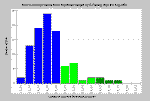 Figure 2. This chart shows the length of the juvenile steelhead in electrofishing samples collected by CDFG in August 1952 approximately 100 yards above the Highway 1 Bridge. Several age classes of steelhead were represented (young of the year = blue, yearling = light green, two year olds = dark green), which indicates that pools were sufficiently deep to support older age steelhead (Reeves, 1988). Aggraded stream systems may sometimes support steelhead young of the year but have diminished capacity to support larger steelhead juveniles.
Figure 2. This chart shows the length of the juvenile steelhead in electrofishing samples collected by CDFG in August 1952 approximately 100 yards above the Highway 1 Bridge. Several age classes of steelhead were represented (young of the year = blue, yearling = light green, two year olds = dark green), which indicates that pools were sufficiently deep to support older age steelhead (Reeves, 1988). Aggraded stream systems may sometimes support steelhead young of the year but have diminished capacity to support larger steelhead juveniles.
These August 1952 samples of the mainstem Garcia River contrast with samples made by German (CDFG, 1968) of the same reaches in August 1968. The latter show a major shift in community structure; suckers were abundant above Highway 1 and were the most abundant species at Eureka Hill Bridge (see Hypothesis #1 Figure 2). This indicates that the cumulative effects from post WW II logging had diminished carrying capacity of the lower mainstem, likely by making conditions warmer and more sediment rich, which favored the native Sacramento sucker. This relationship was advanced by CDFG (1966) in a survey of the Garcia River after the 1964 flood: "Suckers now appear to have replaced salmonids as the dominant fish in a large section of the Garcia River. This can be attributed directly to deterioration of the stream habitat."
By 1991, the lower Garcia River was showing a rebound in terms of its salmonid carrying capacity. The Garcia River Watershed Enhancement Plan (Mendocino RCD, 1992) reported fish observations of the lower Garcia River, where divers counted fish in various habitats during a 1991 habitat typing survey. Salmonids far outnumbered suckers, with numerous older age steelhead present. This indicates that the mainstem was in recovery from past flood damage and that cold water species were dominant; however, coho salmon juveniles were not seen.
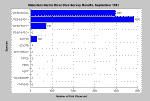 Figure 3. Survey results from on-bank and direct dive observation in 53 habitat units in the mainstem Garcia River below the North Fork from September 5-8, 1991 (MCRCD, 1992). The fish community was dominated by steelhead yearlings and young of the year, along with many two year old steelhead, 30 suckers, four sculpin, and two turtles. More pools than flatwater habitat units were dived, which may account for the high ratio of yearling and older steelhead juveniles to young of the year.
Figure 3. Survey results from on-bank and direct dive observation in 53 habitat units in the mainstem Garcia River below the North Fork from September 5-8, 1991 (MCRCD, 1992). The fish community was dominated by steelhead yearlings and young of the year, along with many two year old steelhead, 30 suckers, four sculpin, and two turtles. More pools than flatwater habitat units were dived, which may account for the high ratio of yearling and older steelhead juveniles to young of the year.
Much of the lower Garcia River was habitat typed for restoration planning purposes (Mendocino RCD, 1992) and habitat data indicates high carrying capacity. Pools constituted 46% of habitats by length, which falls within the optimal range for salmonids (CDFG, 1998). Moreover, greater than 50% of the pools were over four feet deep and 75% were over three feet deep (Figure 4). Brown et al. (1994) found that coho juveniles prefer pools deeper than a meter and Reeves (1988) indicated that steelhead that were more than a year old also need pools at least three feet deep. Consequently, the lower mainstem Garcia provides adequate carrying capacity for steelhead and coho with respect to pool frequency and depth.
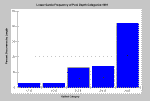 Figure 4. This chart shows the results of a 1991 lower Garcia habitat typing survey with frequency of pool depth categories for the lower mainstem from the North Fork to the estuary. Of the 75 pools measured, 42 were deeper than four feet and 14 were between three and four feet deep. There are many deep pools in the lower Garcia which provide suitable habitat for juvenile steelhead. Carrying capacity increases with increasing pool depth as the lower river recovers from sediment impacts (Hypothesis #5).
Figure 4. This chart shows the results of a 1991 lower Garcia habitat typing survey with frequency of pool depth categories for the lower mainstem from the North Fork to the estuary. Of the 75 pools measured, 42 were deeper than four feet and 14 were between three and four feet deep. There are many deep pools in the lower Garcia which provide suitable habitat for juvenile steelhead. Carrying capacity increases with increasing pool depth as the lower river recovers from sediment impacts (Hypothesis #5).
An August 2002 dive of the lower mainstem Garcia River above Highway 1, at Eureka Hill Bridge, and below the North Fork was carried out by Institute for Fisheries Resources biologist Patrick Higgins. The dive was conducted to compare community structure to Kimsey's electrofishing of the Garcia River at three sites on August 13, 1952 (CDFG, 1953). The August 2002 dive found steelhead to be the dominant species and that the age structure was similar to that sampled in 1952, with numerous yearling and older steelhead present (Figure 5). The dive survey was focused on steelhead abundance and age classification; therefore results likely under represent other species like sculpin, which are low in the water column, and sticklebacks, which are in the margins of the stream. However, observations in August 2002 on the mainstem below the North Fork Garcia in areas sampled by Kimsey (CDFG, 1953) did not find coho salmon juveniles, which may indicate that recovery is not yet complete.
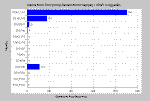 Figure 5. This chart shows survey results from direct observation dives in the Garcia River approximately 100 yards upstream of Highway 1 on August 21, 2002. The fish community was dominated by steelhead juveniles of different age classes with young of the year the major component, but yearling and two year old fish well represented. The lack of suckers and high number and diverse age structure of steelhead juveniles in August 2002 indicate that the mainstem is very favorable for salmonids and continuing its trend of recovery.
Figure 5. This chart shows survey results from direct observation dives in the Garcia River approximately 100 yards upstream of Highway 1 on August 21, 2002. The fish community was dominated by steelhead juveniles of different age classes with young of the year the major component, but yearling and two year old fish well represented. The lack of suckers and high number and diverse age structure of steelhead juveniles in August 2002 indicate that the mainstem is very favorable for salmonids and continuing its trend of recovery.
Many of the lower mainstem areas of large northwestern California Rivers have acute temperature problems (CWQCB, 2002), but the Garcia has relatively cool water temperatures. The maximum floating weekly average water temperature of the mainstem Garcia at the Hooper property, also known locally as Oz, is just slightly warmer than required for coho salmon rearing in some years (Figure 6). However, the lower mainstem Garcia River remains within optimal temperature range for rearing steelhead juveniles, which have a higher thermal tolerance. (See Temperature Background page for more information on temperature tolerance.) The Garcia River Watershed Enhancement Plan (Mendocino RCD, 1992) noted that temperature regimes were cooling as the mainstem recovered from past logging related damage. With incremental improvement, the mainstem Garcia River temperature will once again be suitable for coho salmon.
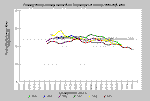 Figure 6. This chart plots floating weekly average temperature of the Garcia River at Oz Hole for the years 1994-1998 and 2001. The values show that conditions were optimal for steelhead trout during most summer periods. The reference for coho salmon juvenile temperature tolerance from Welsh et al. (2001) indicates that conditions for this species were met in 2001 except for one week.
Figure 6. This chart plots floating weekly average temperature of the Garcia River at Oz Hole for the years 1994-1998 and 2001. The values show that conditions were optimal for steelhead trout during most summer periods. The reference for coho salmon juvenile temperature tolerance from Welsh et al. (2001) indicates that conditions for this species were met in 2001 except for one week.
Cross section data also shows improving trends in pool depths in the lower Garcia River, which is consistent with improving carrying capacity for salmonids (See Hypothesis #5).
The following is a list of Topics in KRIS Garcia where you can see data in its context, Metadata and associated Info Links. The large-case letters in parentheses indicate KRIS sub-basins.
(LG) Fish: 1952 Kimsey Electrofishing Garcia River Site #1-3, CDFG)
(LG) Fish: 1968 Net Sampling Garcia River Above Highway 1/Eureka Hill, CDFG
(LG) Fish: 1991 Dive Salmonid Count Lower Garcia River
(LG) Habitat: Pool Depth Frequency Lower Garcia 1991
(LG) Fish: 2002 Dive Salmonid Count Garcia (GAR_1) Above Highway 1
(LG) Temperature: FWA Main Garcia River at Oz Hole 1994-1998 & 2001
Alternate Hypothesis
Juvenile salmonid carrying capacity in the Lower and Middle Garcia River is remaining static.
Although CDFG (1968) samples showed that there were warm water species in abundance in the Lower and Middle Garcia River, overall carrying capacity for salmonids may have been similar in these reaches in 1968 and today. Therefore, there has been no change in salmonid carrying capacity.
Monitoring Trends to Test the Hypotheses
Survey the lower Garcia River to see whether pool depths are increasing or decreasing. Monitor water temperature in the same reaches to see if they begin to fall below temperatures known to support coho juvenile rearing. Continue to monitor index reaches sampled by Kimsey (CDFG, 1953) with electrofishing and direct dive observations to see if coho salmon juveniles once again use the mainstem Garcia River for rearing. Also, sample more extensively to determine the current pattern of distribution and abundance of warm water species, such as the Sacramento sucker.
References
Brown, L. R., P. B. Moyle, and R. M. Yoshiyama. 1994. Historical decline and current status of coho salmon in California. North American Journal of Fisheries Management. 14(2):237-261. [426kb]**
California Department of Fish and Game (CDFG). 1953. Population sampling on three north coastal streams closed to summer trout fishing - 1952 season. First progress report. Written by J.B. Kimsey. CDFG, Inland Fisheries Branch. Yountville, CA. 28 pp. [298kb]
California Department of Fish and Game (CDFG). 1956. Various field notes concerning the Garcia River and tribs, from Leo Shapovalov in 1948 to Holman who recapped in this memo. CDFG. Yountville, CA. 2 pp. [98kb]
California Department of Fish and Game (CDFG). 1968. Memorandum regarding the presence of suckers in Garcia River, 28 August 1968. CDFG unpublished file memo by E. German. Yountville, CA. 2 pp. [16kb]
California Department of Fish and Game (CDFG). 1998. California salmonid stream habitat restoration manual. Third edition. CDFG, Inland Fisheries Division. Sacramento, CA. 495 pp. [6.92Mb]
California Regional Water Quality Control Board (CRWQB). 1998. Clean Water Act 303(d) TMDL timeline for California. CRWQCB, North Coast Region. Santa Rosa, CA. 10 pp. [36k]
Mendocino County Resource Conservation District (MCRCD). 1992. Garcia River Watershed Enhancement Plan. Prepared for the California State Coastal Conservancy. Prepared by MCRCD, written by Jack Monschke and D. Caldon, Kier Associates. Ukiah, CA. 207 pp. [3.1Mb]**
Welsh, H. H., G. R. Hodgson, B. C. Harvey, and M. F. Roche. 2001. Distribution of juvenile coho salmon (Oncorhynchus kisutch) in relation to water temperature in tributaries of the Mattole River, California. North American Journal of Fisheries Management . 7 pp. [335kb]